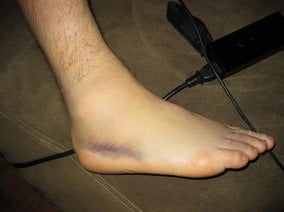Nothing is worse than getting a sprained ankle while on a camping trip far from help or civilization. Here are some things to know about how to prevent, diagnose and treat ankle sprains while camping.
Camping deep in the wilderness away from the hustle and bustle of the city has an abundance of benefits, but if you ever get injured while far away from help, the results could be disastrous. Camping alone has a range of risks you should be aware of, but camping at a great distance from civilization, whether alone or in a group, also carries a major risk whenever you sprain an ankle. If you’re going on a rigorous camping trip, here are a few things to remember to prevent, diagnose and treat a sprained ankle.

How to prevent a sprain from happening
- Wear the right camping/hiking shoes – You can decrease the risk of spraining an ankle by investing in proper hiking shoes and socks. The ideal hiking shoe should provide ankle support and should never be too big. Wearing shoes that are even a little too big increases the risk of an ankle sprain, because it interferes with your balance. If you know you have weak ankles, but are still planning on going on an intense hiking trip, consider wearing an ankle brace for additional reinforcement. However, some people warn against that idea, because braces might reduce balance.
- Be careful while walking – Even though this may seem obvious, many people are not careful while walking on uneven terrain. Always watch where you’re stepping and make sure you have good footing before putting your weight on the step. By doing this consistently, you can significantly decrease the risk of ankle sprains.
- Take additional supplies – You never know what type of injury you’re going to run into, which is why it’s extremely important to always take along a first aid kit while camping. Most kits come with aspirin, bandages and splints. Amazingly, duct tape is a great resource to take camping, and even works as a backup medical supply for making makeshift bandages.
How to diagnose a sprained ankle
- If you tweak your ankle, check for swelling – Despite taking the aforementioned precautions, accidents still occur all the time. A sudden sharp pain caused by a misstep is usually the first indication of a sprain. You should immediately stop at the side of the trail, take off your shoe and check for swelling or discoloration. If there’s redness or swelling, it could be a sprain.
- Assess the pain – A sprained ankle has a dull, consistent throb. If the pain is sharp and intermittent that could be the sign of a more serious injury. Sprained ankles should not be overly painful unless moving.
- Try to move your foot from side to side – Sprained ankles have a limited range of mobility, so test your ankle by moving your foot from side to side. If there is sharp pain, it’s most likely a sprain.
How to treat a sprained ankle
- Begin treatment immediately – Once you’ve diagnosed the injury as a sprain, it’s important to treat it immediately. Some people may be inclined to continue camping through the pain, but this will only do more damage to the injury.
- Elevate your ankle – The first thing you should do is elevate your ankle above your chest. If possible, lie down on the ground and prop your foot on a boulder or tree stump.
- Wrap it up – If your ankle is not swollen, that is a good sign, but it doesn’t necessarily mean you’re out of the woods. Put a boot on and lace it tightly around your ankle if it’s not too painful. If it is extremely painful and swollen, wrap it in a compression bandage. It should be tight, but not tight enough where the circulation is completely cut off.
- Start heading back from the campsite where you can get medical attention and rest – When the ankle is completely wrapped, you should end the camping trip and head back to civilization. Depending on the severity of the sprain, you may need to get help from friends, use a sturdy walking stick or possibly be carried to safety by a group. If you’re walking alone with a stick, it’s important to rest every now and then and elevate your ankle so the injury doesn’t get worse.
Need to purchase camping gear? Browse our huge inventory of camping supplies here.



